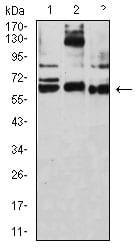


| WB | 1/500 - 1/2000 | Human,Mouse,Rat |
| IF | 咨询技术 | Human,Mouse,Rat |
| IHC | 咨询技术 | Human,Mouse,Rat |
| ICC | 技术咨询 | Human,Mouse,Rat |
| FCM | 1/200 - 1/400 | Human,Mouse,Rat |
| Elisa | 1/10000 | Human,Mouse,Rat |
| Aliases | CDSIGN; CLEC4L; DC-SIGN; DC-SIGN1 |
| Entrez GeneID | 30835 |
| clone | 5C2G9 |
| WB Predicted band size | 45.8kDa |
| Host/Isotype | Mouse IgG1 |
| Antibody Type | Primary antibody |
| Storage | Store at 4°C short term. Aliquot and store at -20°C long term. Avoid freeze/thaw cycles. |
| Species Reactivity | Human |
| Immunogen | Purified recombinant fragment of human CD209 (AA: extra 270-404) expressed in E. Coli. |
| Formulation | Purified antibody in PBS with 0.05% sodium azide |
+ +
以下是3-4条关于CD209(DC-SIGN)抗体的参考文献及简要摘要内容:
1. **文献名称**:*DC-SIGN mediates antigen capture and innate immune activation in response to HIV-1*
**作者**:Geijtenbeek TBH et al.
**摘要**:研究揭示了CD209(DC-SIGN)作为树突状细胞表面的C型凝集素受体,能够直接结合HIV-1病毒颗粒,并通过与T细胞相互作用促进病毒传播,同时触发先天免疫信号通路。
2. **文献名称**:*Mycobacterium tuberculosis exploits the DC-SIGN receptor to suppress host immune responses*
**作者**:Tailleux L et al.
**摘要**:该文献发现结核分枝杆菌通过CD209受体入侵树突状细胞,并利用该受体抑制宿主免疫应答,提示靶向CD209的抗体可能干预病原体逃逸机制。
3. **文献名称**:*Targeting DC-SIGN via its carbohydrate recognition domain for antibody-mediated neutralization of pathogens*
**作者**:van Kooyk Y et al.
**摘要**:研究通过解析CD209的糖识别结构域,开发特异性抗体阻断其与病原体(如埃博拉病毒、SARS-CoV-2)的结合,为抗感染治疗提供新策略。
4. **文献名称**:*Antibody-directed targeting of DC-SIGN promotes dendritic cell-mediated cross-presentation of tumor antigens*
**作者**:Sancho D et al.
**摘要**:利用CD209抗体偶联肿瘤抗原,增强树突状细胞的抗原呈递能力,激活抗肿瘤T细胞反应,验证了CD209在癌症免疫治疗中的应用潜力。
以上文献均聚焦于CD209在病原体识别、免疫调控及抗体靶向治疗中的作用。
**Background of CD209 Antibody**
CD209. also known as DC-SIGN (Dendritic Cell-Specific Intercellular adhesion molecule-3-Grabbing Non-integrin), is a C-type lectin receptor predominantly expressed on dendritic cells and macrophages. It plays a critical role in pathogen recognition, immune response modulation, and cell-cell interactions. Structurally, CD209 contains a carbohydrate recognition domain (CRD) that binds high-mannose glycans on pathogens like HIV, Ebola virus, Mycobacterium tuberculosis, and Candida albicans, facilitating their uptake and presentation to T-cells.
CD209 antibodies are essential tools for studying its function in infectious diseases, inflammation, and cancer. In research, these antibodies help detect CD209 expression in tissues or cells, enabling insights into its role in viral entry, immune evasion, and tumor microenvironment interactions. For instance, CD209-mediated HIV capture by dendritic cells promotes viral dissemination to T-cells, making it a potential therapeutic target.
Clinically, CD209 antibodies have diagnostic and therapeutic implications. Elevated CD209 levels correlate with disease severity in infections or inflammatory conditions, while blocking antibodies may inhibit pathogen uptake or dampen excessive immune responses. Additionally, CD209's involvement in cancer metastasis highlights its relevance in oncology research.
Overall, CD209 antibodies bridge mechanistic studies and translational applications, offering avenues for novel diagnostics, vaccines, and immunotherapies targeting infectious and immune-mediated diseases.
×